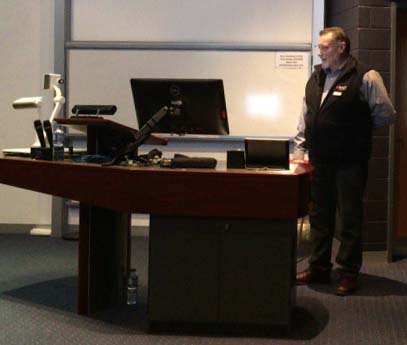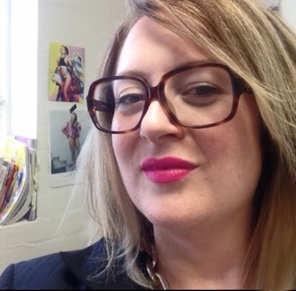Readers of this blog will already know I’m somewhat skeptical of the claims made by the proponents of osteopathy. If you’re at all unsure about where osteopathy sits in relation to current science, I’d recommend reading my previous post on the topic.
RMIT University offers a degree course in osteopathy. I went along to RMIT’s Open Day to take a look at how osteopathy is promoted to prospective students looking for an interesting career in the health sector.
Osteopathy is a kind of quaint, old-fashioned, pre-scientific health care system. Practitioners generally offer forms of joint manipulation and massage in addition to the usual advice offered by many health practitioners – lifestyle, exercise and food. It can be quite hard to distinguish the treatments offered by osteopaths from those of chiropractors. The main difference between osteopathy and chiropractic is historical. The founder of osteopathy was Andrew Taylor Still (1928 – 1917). He appears to have worked by intuition alone and his pronouncements sounded plausible at the time.
The choice of university course is such a big decision in one’s life. It’s a daunting investment in time and money at a stage in life when you’re trying hard to get a career established. It could take a significant proportion of one’s working lifetime to pay back a big HECS debt. I believe it’s important that potential students are given accurate information about what they’re getting into before they enrol.
Other matters worth considering are:
Are Australian taxpayers getting value for money in the teaching of osteopathy? Should the regulators (AHPRA and TEQSA) investigate if dubious claims are being made? How can you tell if osteopathy is just an elaborate placebo, or not?
I’m erring on the side of the placebo idea, but I’m ready to be convinced if the right evidence is put forward.
I wrote to RMIT expressing my concerns about what I saw and heard at Open Day. Here is that letter (some names have been removed):
Dear (RMIT’s communications department person)
I’m a blog writer for the Australian Skeptics (Victorian Branch). I’m sure you’re aware that Sunday 9 August 2015 was RMIT’s Open Day, a valuable opportunity for members of the public to see what’s happening and what courses are available at RMIT.
I hope the answers to my questions below will allay my concern for potential students who might be attracted to both an expensive and time-consuming course but based on misleading information.
Prior to Open Day, I requested an interview with Dr Ray Myers, Head of Discipline RMIT Osteopathy. Dr Myers declined my request but suggested I contact you.
I listened to the public presentation in relation to the Osteopathy degree course. I’ve also recently reviewed the information provided on RMIT websites about osteopathy.
I note the claim on one of Dr Ray Myer’s presentation slides: Osteopathy can assist with asthma (amongst a list of other health conditions). A claim similar is made on two separate RMIT webpages [1] [2].
“Some people find osteopathy also helps in the co-management of conditions such as asthma and period pain.”
Being of a slightly skeptical nature, I decided to check the claim against the scientific/medical literature. In relation to the efficacy of osteopathy treatment of asthma, I found this systematic review [3] which included an investigation of osteopathy. In the conclusions section it states:
“Spinal manipulation is not effective for asthma…”Question 1. Could I enquire about the evidence that RMIT are relying on for the above website claims?
Question 2. Asthma is commonly a childhood health condition and the claim about asthma is found on the website about the public osteopathy clinic. My question is: Are children or infants also receiving osteopathy treatments at the RMIT teaching clinics?
Also
In relation to the claim that osteopathy treatment is effective for period pain (the medical term is ‘dysmenorrhoea’).
I again read the literature and searched for information about osteopathy and the ability to relieve period pain. I found another systematic review of the available evidence [4]. The review looked at spinal manipulation, which is a treatment commonly offered by both chiropractors and osteopaths.
Conclusion: “Overall there is no evidence to suggest that spinal manipulation is effective in the treatment of primary and secondary dysmenorrhoea.”Question 3. Which sound evidence is RMIT relying on for the claim that osteopathy treatment is effective for period pain?
I think it’s important to address these concerns as it appears that your claims may be misleading and lacking in sound evidence from peer-reviewed studies.My concern is that in an effort to attract new students to RMIT courses, the efficacy of osteopathy treatments may be somewhat exaggerated.
During Dr Myers osteopathy presentation, a typical osteopathic consultation was mapped out in a presentation slide. I learnt that after a student or graduate performs the initial patient diagnosis and/or a physical assessment, the patient is then referred to a regular GP or remains with the osteopath for treatment. Question 4. Could you please list the health conditions, when diagnosed, that you would suggest patients be treated with osteopathy and not referred to a GP?When I’ve previously asked questions about RMIT chiropractic and TCM courses I wasn’t given very satisfactory answers. I would like to highlight that I’m specifically asking about ‘efficacy’, not safety. I’m also interested in the relevance that osteopathy has with sound scientific principals and evidence. The regulation of osteopathy by AHPRA doesn’t necessarily support the scientific validity of the treatments offered.
Please feel free to forward my questions to RMIT’s osteopathy department I look forward to your prompt response within the fortnight. Please note that Australian University regulations encourage public comment [5].
I look forward to your input,
Mal Vickers[1] RMIT Osteopathy Clinic
[2] RMIT Health Science Clinic
[3] Effectiveness of Manual Therapies: the UK Evidence Report
[4] Spinal manipulation for primary and secondary dysmenorrhoea
[5] Higher Education Standards Framework 2011, Section 4.3
“ensure that academic staff are free to make public comment on issues that lie within their area of expertise…”
This was RMIT’s curious response:
You might find useful a recently published study by Burke, S., et al. (2013). “A profile of osteopathic practice in Australia 2010-2011: a cross sectional survey.” BMC Musculoskeletal Disorders 14(1): 227. [Study full text]
My reply:
Dear (RMIT’s communications department person),
Thanks for your response.
The journal paper you sent me was a survey that simply tries to establish what osteopaths in Australia are doing:
“The purpose of this study was to describe the current activities of Australian osteopaths…”
In my first email I asked about RMIT’s claims that osteopathy can effectively treat asthma. The word ‘asthma’ doesn’t appear in the survey results you sent. A survey generally lacks any controls, such as placebo controls which might objectively establish how effective a treatment may be. Clinical trials (not surveys) are highly regarded when trying to establish efficacy by professional science reviewers. The paper itself says it’s not an objective test of efficacy:
“There is a need for objective evidence to test these patient outcomes…”
Here’s an example of a clinical trial of osteopathy that includes a placebo control [1]. This trial looked a back pain and tested osteopathy against ‘sham manipulation’. No improvement was found in the treatment group (genuine osteopathy).
I’m puzzled as to why anyone whom I assume are critical thinkers, might consider this as evidence that osteopathy is effective for asthma.
I’m curious to know why you sent me the survey by Burke et al?
Would you please consider my queries?
Regards
Mal[1] Osteopathic manipulative treatment for chronic low back pain: a randomized controlled trial
I’ve since heard nothing from RMIT about this topic. They skirted my questions about various conditions and the treatment of children at RMIT’s osteopathy teaching clinics. I genuinely thought they might like to list the health conditions where there may be some efficacy in favour of osteopathy, however they didn’t answer that question either. It was disappointing, as I might have learnt something.
A practitioner survey could simply mean that your marketing is effective, not necessarily the treatments you offer. Many health conditions get better even if you do nothing at all. If you advertise that you can treat back pain and people turn up to get treatment and are counted in a survey, that’s not surprising.
The osteopathy presentation I listened to at RMIT Open Day was clear about the foundations of osteopathy. The first school of osteopathy located in Kirksville Missouri USA, was opened by Andrew Taylor Still in 1892. His writings can be found online:
God is the Father of Osteopathy, and I am not ashamed of the child of His mind.
And
My highest and most profound worship is when I take up any part of the human body or any part of nature, and after examining it under the microscope, I give credit for all perfection to the great Architect.
Taylor Still seems to be on a mission from God. There’s a definite Christian church sermon feel and style to Still’s writings and speeches. He was the son of a Methodist minister after all.
You begin with anatomy, and you end with anatomy, a knowledge of anatomy is all you want or need . . .
What about pathology, surgery, biochemistry, immunology, and microbiology? It’s interesting that Louis Pasteur’s work on germ theory (published 1880) slightly pre-dates the opening of the first osteopathy school. Germ theory has been a huge benefit to health science by helping us understand and avoid infection, but I’ve seen no reference to it in Still’s writing.
Osteopathy is to me a very sacred science. It is sacred because it is a healing power through all nature.
“Sacred science”? No, real science is hard, it’s done by people, it’s argued about in detail and gains are hard won. Andrew Taylor Still shouldn’t be trying to put osteopathy beyond criticism by making it sacred. It looks and smells like pseudoscience to me.
If the study of osteopathy at RMIT was a scholarly look at this historical form of medicine I wouldn’t be at all concerned. However, I didn’t get that impression as RMIT wants to train students to become practitioners; not historical researchers.
Graduates are primarily employed or self-employed in private osteopathic clinics or multidisciplinary clinics.
During RMIT Open Day I also took a tour of the new teaching clinics. This is where osteopathy students, under supervision, learn how to perform treatments on members of the public. You can get a cheap osteopathy treatment at the teaching clinics (not that I’m recommending it). The clinic rooms are shared with other health disciplines; psychology, Chinese Medicine and chiropractic. This building has many consultation rooms spread over two levels. The building is new and cost approximately 28 million to build.
The osteopathy students I met during the tour appeared to be motivated, enthusiastic and genuine people. I’ve no doubt they think they’re doing the right thing, they want to help people live healthy lives, a very noble aspiration. Unfortunately thinking nice things isn’t good enough anymore, we know people (including myself) are too easily fooled by elaborate placebos. For osteopathy to be taken seriously it needs good repeatable results from well conducted placebo controlled trials. it’s not rocket surgery (note to self, must not mix metaphors).
Anyone can walk into an osteopathy clinic in Australia with any health condition and do so without a referral. Whilst I wouldn’t want to interfere with people’s right to choose, isn’t that kind of risky if this is an area of healthcare that isn’t backed up by good evidence? Shouldn’t all frontline health practitioners in our health system get the best in evidence-based practice so that we’re doing the best we can for our community? Here are some examples of osteopathy treatments that didn’t go well.
The history of osteopathy and what I saw of the uncritical promotion of it at RMIT leads me to an uncomfortable conclusion; the claims made by RMIT about the efficacy of osteopathy in the treatment for specific health conditions are misleading. There currently isn’t any sound supporting evidence for such claims. I gave RMIT plenty of opportunity to point me in the right direction. I was underwhelmed by the survey that they sent me in response.
The saddest thing about the favourable claims for osteopathy made by RMIT was that those claims were made to motivated, enthusiastic, impressionable young people who don’t realise it’s essentially an expensive road to pseudoscience and quackery. What more can I say? I wish them well.

















Reblogged this on The Logical Place.
RMIT is a joke for promoting this woo. After such a proud history, it is a tragedy it has resorted to what is a money grab to cater for those less logically and scientifically challenged among us.
The chief woo-ster is this fellow;
http://www.rmit.edu.au/contact/staff-contacts/academic-staff/c/cohen-professor-marc/
Google him and you will see him on YouTube, both ridiculous and scary that a doctor (a real one, not a jumped up chiro or osteo witchdoctor) can believe in ideas so anti-science. I wonder when he stopped believing in Avogadro’s Number so that he could consider homoeopathy as credible?
As an RMIT alumnus I also find this very sad.
The issues you have identified above are more to do with the medical regulator rather than the profession or the degrees offered given the programs across Australia are similar SCU and VU, just because VU offers a masters does not mean it is any better and furthermore, if you are comparing this to america or some european countries etc well, there regulator is different as it requires that individual study osteopathic medicine which is a sub-specialty of the Doctor of Medicine (Medical practitoner), you will also find that lots of osteopathic students go on to complete further studies overseas that at the equivalent of medicine so they are suitably qualified. If you have an issue, i would direct this to AHPRA as they set the standard for practice not the university in australia. I will remind you that they also set the standard for most or all clinical health professionals in australia and I would be concerned more about some of the medical practitoners coming out of university rather that a complimentary medicine meaning to complement western medicine not override it you flog. and face it when you study medicine or any of the associate health science you get that and there all ways going to be individual to controversal ideas.
there are also plenty of procedures completed by other health professionals including medical practitioners and specialist that have gone serious wrong but we continue to go and see them because someone else told us it was a good idea to see them but people dont tell you its a good idea to go to a osteo or chiro or physio!!!!!. come one get a grip mate your uneducated or sorry you have been educated to line to pockets of pharmaceutical companies and your local GP. maybe take a read of the china study or view the video forks over knifes this might help you to open your mind around health sciences.
Hi Shane, just because accidents occur in medicine does not mean that osteopathy works or is somehow perfectly safe. I’ve concentrated on the issue of efficacy in the post – if there is no evidence of efficacy then no amount of risk, no matter how small, is worth it. Your arguments are not good enough to cover for the missing evidence of efficacy. China study? Would you kindly post a link and an explanation as to why it can’t be found on PubMed. Thanks for taking an interest in this issue.